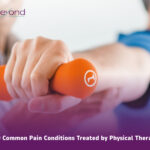Physical therapy for hypermobile joints is effective for various joints in our body. Have you sprained an ankle? Dislocated your shoulder? Experienced whiplash? You may have joint hypermobility. Although ankle sprains, whiplash, and shoulder dislocations sound like very different injuries, they all often result in hypermobility. Repetitive re-injury to these parts of your body may develop into pain or muscle stiffness due to unstable or hypermobile joints. Proper physical therapy for hypermobile joints is essential in treating these injuries and so many others.
What causes Hypermobile Joints?
In the physical therapy field, hypermobility is also known as instability or joint laxity. There are a variety of reasons for hypermobile joints. Hypermobile joints are often caused by repetitive overuse or trauma. A chronically sprained ankle. Whiplash from one or more car accidents. An unstable shoulder from a fall or sports injury. When the source of pain is caused by joint laxity, it is often misdiagnosed or treated improperly. Why? Because hypermobile joints are often masked by pain, muscle guarding and limited range of motion. Physical therapy for hypermobile joints may be extremely beneficial. Depending on which part of the body is affected.
A series of questions can help determine if hypermobile joints cause this discomfort. Some of these questions may include.
- Do you experience more pain at rest compared with activity?
- Is it hard falling asleep or staying asleep without waking in pain?
- Have you experienced catching in your joint(s) with certain movements?
- Does your pain worsen sitting or standing? Or improve with activity?
If so, you may experience something called hypermobility or instability in your joints. Physical therapy for hypermobile joints focuses on strength, stability and proprioception.
What to Expect
Common Symptoms
It is natural to think an injury can only worsen with certain movements. However, someone with instability may actually feel better with activity. While experiencing more pain or discomfort at rest. If you find yourself in more pain when sitting, standing or sleeping. Such static postures can actually increase your symptoms, as walking or moderate exercise can reduce them when there is an unstable joint in the body. Our body innately understands it needs to protect this area. Utilizing larger muscle groups to tighten may result in spasms, aches, or limit the range of motion. Our brain is essentially telling our body to tighten, spasm, ache or cause pain so that we eventually move around or change positions so that our muscles and ligaments activate and stabilize the area.
Common Injuries
Physical therapy for hypermobile joints can address a variety of injuries. The most commonly seen include ankle sprains, shoulder subluxations or dislocations and whiplash. Such a diagnosis can be related to stretched ligaments that are no longer providing support to a joint from overuse (i.e., repetitive ankle sprains or repetitive shoulder dislocations or subluxations where the joint can come out of the socket, or trauma from a car accident, for instance). It can also be related to genetics, spinal deformities, or degeneration, causing changes to the bone structure.
Physical Therapy Helps Hypermobility
If you experience such symptoms, physical therapy for hypermobile joints incorporates exercises that focus on strengthening and improving endurance. Keep in mind that it is essential to strengthen the smaller, postural muscles that surround such joints to provide support.
Shoulder Injuries
For example, shoulder injuries. Unstable shoulders need strength and endurance of the rotator cuff as well as muscles between the shoulder blades to support the shoulder girdle. Strong biceps, pecs and deltoids are helpful in keeping your shoulders stable and are the most common muscles strengthen at the gym. These muscle are often already overworked. And cannot provide true stability to the shoulder joint itself. Rather, strengthening deep rotator cuff muscles help support your shoulder joint. Not only for stability, but for long term healing and injury prevention.
Ankle Sprains
On the other end of the spectrum, repetitive ankle sprains are also very common. Many ligaments support the ankle joint. These ligaments stretch like rubberbands. Although they have a lot of give. When these ligaments are overstretched from re-injury, they lose there elasticity. Strengthening the muscles in and around your feet and ankles is also essential. As are balance exercises. Balance exercises such as standing on one foot or tandem walking can help with proprioception, which is knowing where your body is in space. Ligaments connect bone to bone. And these ligaments have receptors that communicate with the brain. The brain can then send the proper signals back to the body to help with timing and coordination of movement between large and small muscle groups.
Whiplash
When experiencing hypermobility in the cervical spine from a whiplash injury. Individuals complain of pain while sleeping, looking down at the computer or looking up for an extended period of time. Whiplash physical therapy for hyperomobile joints incorporates strength and endurance exercises for the deep neck flexors. The abdominal muscles for your neck. These are very important muscles to retrain. Incorporating eye movements with your neck and head movements for added proprioception. Helps stabilize the deep postural muscles supporting the spine itself.
Strengthen vs. Stretch
In general, physical therapy for hypermobile joints focuses on building strength of small postural muscles and awareness through ligament stabilization. Starting with exercises lying on your back. Then progress toward more challenging exercises in sitting and standing. All of which build connections between the brain and body for better coordination and long term injury recovery as well as prevention.
When it comes to physical therapy and hypermobile joints, do be careful with stretching. Stretching can actually aggravate your symptoms. As mentioned earlier tightness or stiffness are common symptoms. However, tightness or stiffness does not always mean you need to stretch. In the case of instability, it is your body’s way of asking you to simply move. Get your blood circulating. Something as simple as walking around after you have been sitting or standing for an extended period of time. Getting your blood flowing may diminish the sense of tightness or stiffness you were experiencing. Our body is smart. Listen to what is saying to you. As you move and strengthen safely. Become more stable and have less pain. When your joints are supported by proper muscles and ligaments, stiffness can slowly diminsh.
In Closing
If you are not sure if you are experiencing instability, contact your local physical therapist in regards to treatment for hypermobile joints. In addition to physical therapy, PRP, prolotherapy and/or stem cell regenerative medicine can also be extremely helpful in healing unstable joints from ligament or tendon injury. Physical therapy after PRP injections will continue to help stabilize, strengthen and balance the area of injury providing long term pain relief while improving overall function. Turn pain and weakness into strength and vitality.
















